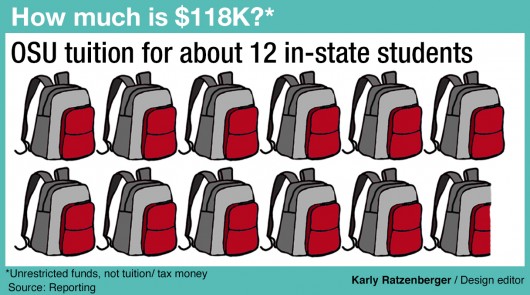
Click to expand.
Of the more than $337,000 that has been spent on the presidential search process so far, roughly 28 percent was used to advertise Ohio State’s Symposium on the University Presidency in August.
About $95,630 was spent on advertisements in The New York Times, The Columbus Dispatch and The Chronicle of Higher Education, according to the symposium cost breakdown, emailed to The Lantern Wednesday by OSU spokesman Gary Lewis to fill a public records request filed Aug. 16.
The symposium, a discussion about what qualities a president should have and what a president should expect in his or her term, was held Aug. 30 at Ohio Union.
Lewis said the ads were necessary to spread the word about OSU’s search.
“The symposium was one component of the university’s approach to help frame its search for a new president of OSU. Advertising the symposium was a key strategy to support our ability to reach and inform potential candidates and leaders about Ohio State’s search for its next president,” Lewis said in a Friday email.
He added the costs were “standard pricing for this type of marketing.”
The symposium cost nearly $118,000 total, including travel, hotel rooms, transportation, advertising, dinner and honoraria, which are payments given for professional services on which there is no set price, according to the cost breakdown.
The symposium was hosted by Harvard Graduate School of Education professor emeritus Richard Chait. Tufts University President Emeritus Lawrence Bacow, Washington State University President Elson Floyd, University of North Carolina system President Thomas Ross and University of Virginia President Teresa Sullivan were the panelists, and Tulane University President Scott Cowen was scheduled as one of the guests, but was unable to make it because he was “stuck in the airport,” Chait said Aug. 30.
The other portion of OSU’s search-related expenses came from its contract with a private search firm.
OSU signed a contract worth more than $220,000 Sept. 17 with R. William Funk & Associates, a Dallas-based firm. The university is set to pay the firm a fixed fee of $200,000, as well as reimburse the firm for direct, out-of-pocket expenses and an additional cost of $20,000 to cover administrative and support expenses, according to the contract.
Lewis said no student money is being used to fund the symposium or the search firm.
“Unrestricted funds were used to cover all costs associated with the symposium. No tuition or tax dollars were used for the symposium,” he said in the Friday email. In a Sunday email, Lewis said unrestricted funds are also covering the search firm contract costs.
Unrestricted funds are given by a donor to an organization to be used as the organization sees fit.
Nearly $5,000 of the symposium’s expenditures was allocated to travel costs for the visiting university officials, and $780 was spent on their rooms at a Hilton hotel. An approximate additional $100 was spent on fruit, water and chocolates in the “room for visiting presidents.”
Other visit-specific charges included a nearly $150 dinner and a $772 limo service. Ross, Bacow and Floyd were also each compensated with a $2,500 honorarium, according to the document.
OSU also paid Bartha Events nearly $3,000 to stream the event live online, spent more than $330 printing programs for the event from UniPrint and paid Ohio Union Events about $4,800 for the symposium.
It has been more than four months since former OSU President E. Gordon Gee announced his retirement June 4. Gee retired July 1, the same day Interim President Joseph Alutto assumed the position.
The announcement of Gee’s retirement came days after controversial remarks Gee made at a Dec. 5 OSU Athletic Conference meeting became public. Comments about Notre Dame and the Southeastern Conference in particular brought national attention.
The finalized presidential profile, an eight-page document which describes the qualities of the ideal next president meant to be sent to potential candidates, was released Wednesday.
The document is set to be formally approved by the Board at its Nov. 7 and 8 meeting. The Presidential Search Committee’s advisory subcommittee was still working on the university portrait, a 30 to 40 page document intended to be a recruitment tool to inform candidates of OSU’s attractive qualities, as of Sept. 19.
A Sept. 15 university statement said all candidates and finalists of the presidential search will be kept private.
Presidential Search Committee Chair Jeffrey Wadsworth said July 19 the process is expected to take about 300 days based on how long searches take at other universities considering outside candidates.


